- DGK Viper 8.125 Deck Review: An Overall Good Board - April 20, 2022
- Best Skateboard Bearings Guide: All You Need Consider - January 27, 2022
- Most Famous Old School Skateboarders - January 27, 2022
When starting on your skateboarding journey, it’s all about finding joy in the small things. Skateboarding, at least in the initial stages, is a massive undertaking and a grind. Beginners will at best only be able to ride around, turn and maybe do a very shaky ollie. With these tools in your arsenal, it can be very tempting to give up altogether and find a sport with a less steep learning curve. However, we would urge you to stick with it, as there are several fun and easy tricks that you can do to fill the time until the more complex movements come naturally.
Having a repertoire of easy tricks that you can call upon is so important in the early learning stages. Not only does this allow you to showcase your skills to your pals. It also allows you to switch your focus to something that you can do consistently instead of suffering the monotony of failed trick after failed trick. Plus, it allows you to participate in fun games like S.K.A.T.E. provided your friends don’t mind playing ‘anything counts’.
However, you may be wondering what these easy tricks are and how to pull them off. Well, that’s exactly why we have put this guide together. In this guide, we take a look at the easiest tricks available to skaters which are immediately attainable, provided you are comfortable on a skateboard. So without further delay, here is our guide detailing the easiest skate tricks out there.
What Makes a Skateboard Trick Easy/Hard?
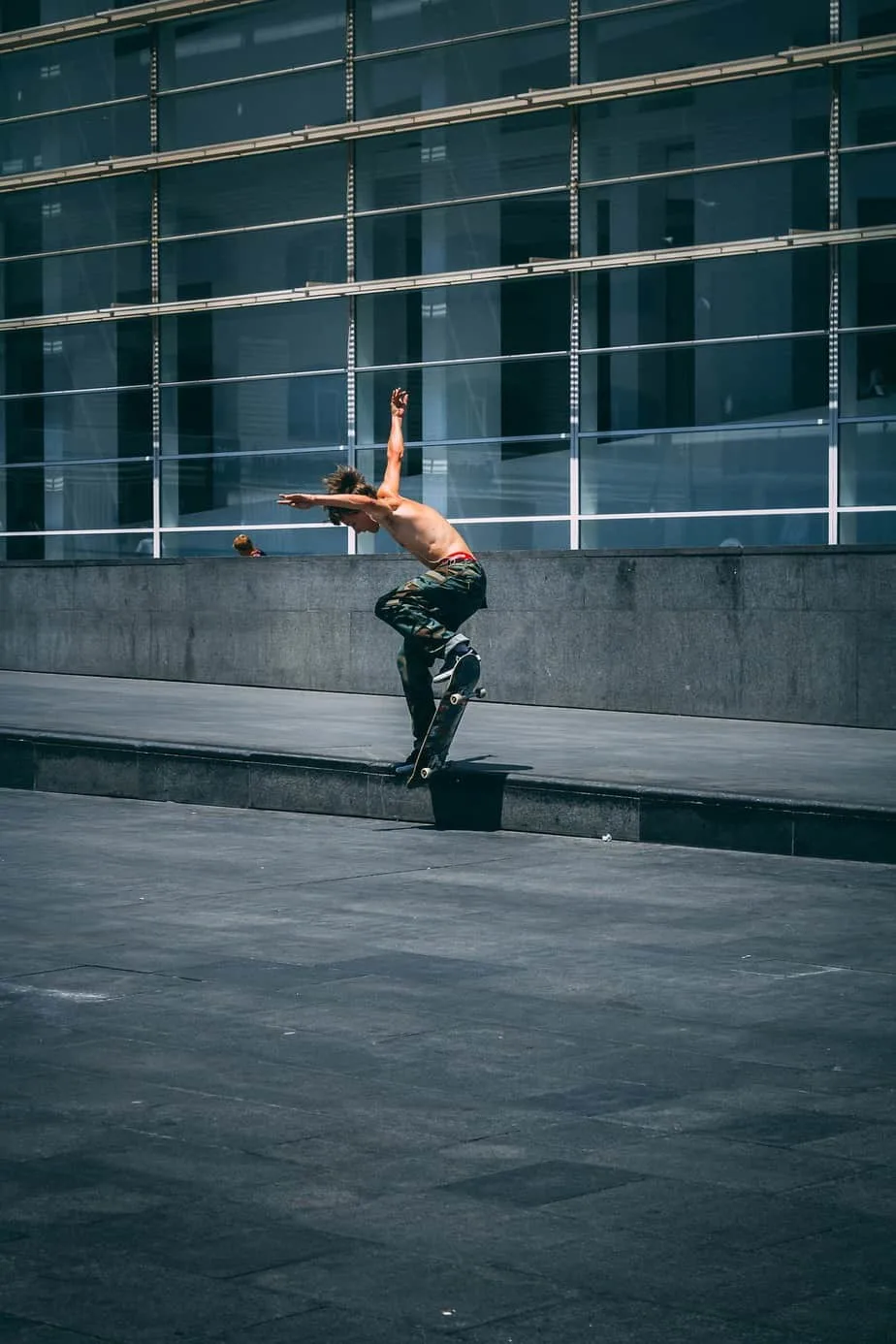
Firstly, it’s important to understand what makes a trick more difficult than another. There are several aspects of a trick that make it more nuanced and complex than your run of the mill movements and these components can be combined to create truly awe-inspiring feats. Below is a quick rundown of what to look out for when trying to gauge the difficulty of a trick.
Pop
This one for a lot of tricks is simply unavoidable. To perform almost every flip trick, you will need to be able to ollie off the ground, giving the board enough space to rotate in the air. Then with tricks like grinds, some lip tricks, grabs and rotations, you’ll need to be able to pop off the ground too. So, if the trick you want to perform incorporates this, you will need to have an ollie in your locker if you want to consistently land it.
Spin
Next, we have spin. This is when your board’s grip tape is consistently facing the sky. However, by scooping your back or front foot, you spin the board so that it spins, kind of like a helicopter propeller. You don’t necessarily need to be able to ollie to complete tricks of this nature. For example, a shove-it can slide along the ground so long as it makes the rotation. However, when you get into tougher tricks like a big spin or a 360 shove, it’s very hard to complete these tricks without an ollie. So be sure to think carefully about your current abilities before you commit to learning a spin trick.
Flip
Flip is when the board makes a full rotation in the air, where the grip tape begins facing the sky, rotates around so that it faces the ground at some stage, and then the skater lands back on the board after the rotation is complete. The most common tricks in this category are the kickflip, heelflip, varial and tre-flip. As mentioned above, you will have a very hard time landing any of these tricks without a decent ollie in your arsenal, so be sure to get this down before you go in search of your first flip trick.
Rotation
A rotation in the context of skateboarding is when the skater and the board make at least a half rotation when in the air. This could be an FS/BS 180 or 360. This could be a half cab, caballerial or the rotation could be even higher if you are skating transition or vert. This is not to be confused with the sex change which is when the board remains in its starting position and the skater makes at least a 180-degree rotation in mid-air, which is much more attainable in the early stages of skating.
Balance
Balance is a little harder to define in the context of skateboard tricks, as all tricks require some level of balance. However, some tricks require more than most. The best examples of these tricks would be manuals, grinds, stalls and even some flip tricks that require strange foot positions or specific pressure applied to the board to complete. So take note of the technical aspects of the trick and try to gauge if your balance and comfort on the board is up to the task.
Timing
Timing does not come into play in a big way most of the time. Much like balance, it always plays a role but rarely has a starring role. However, some tricks need you to be very precise with your timing. The best examples of these tricks would be late flips and double flips where flicking the board and catching the board after a hard flick can prove quite a challenge unless your timing is on the money.
Confidence
Then lastly, there is a factor that is often overlooked but plays a vital role. Confidence in the context of a skateboard trick can be the difference between a land and a bail. If you have the confidence to commit to huge drops, large ramps or more technical moves which could end badly, you have much more chance of landing the trick than someone that approaches the task in a tentative manner. Remember, you can’t land any tricks that you don’t try, so be brave and give it your best shot.
What Fundementals Should You Learn Before Tricks?
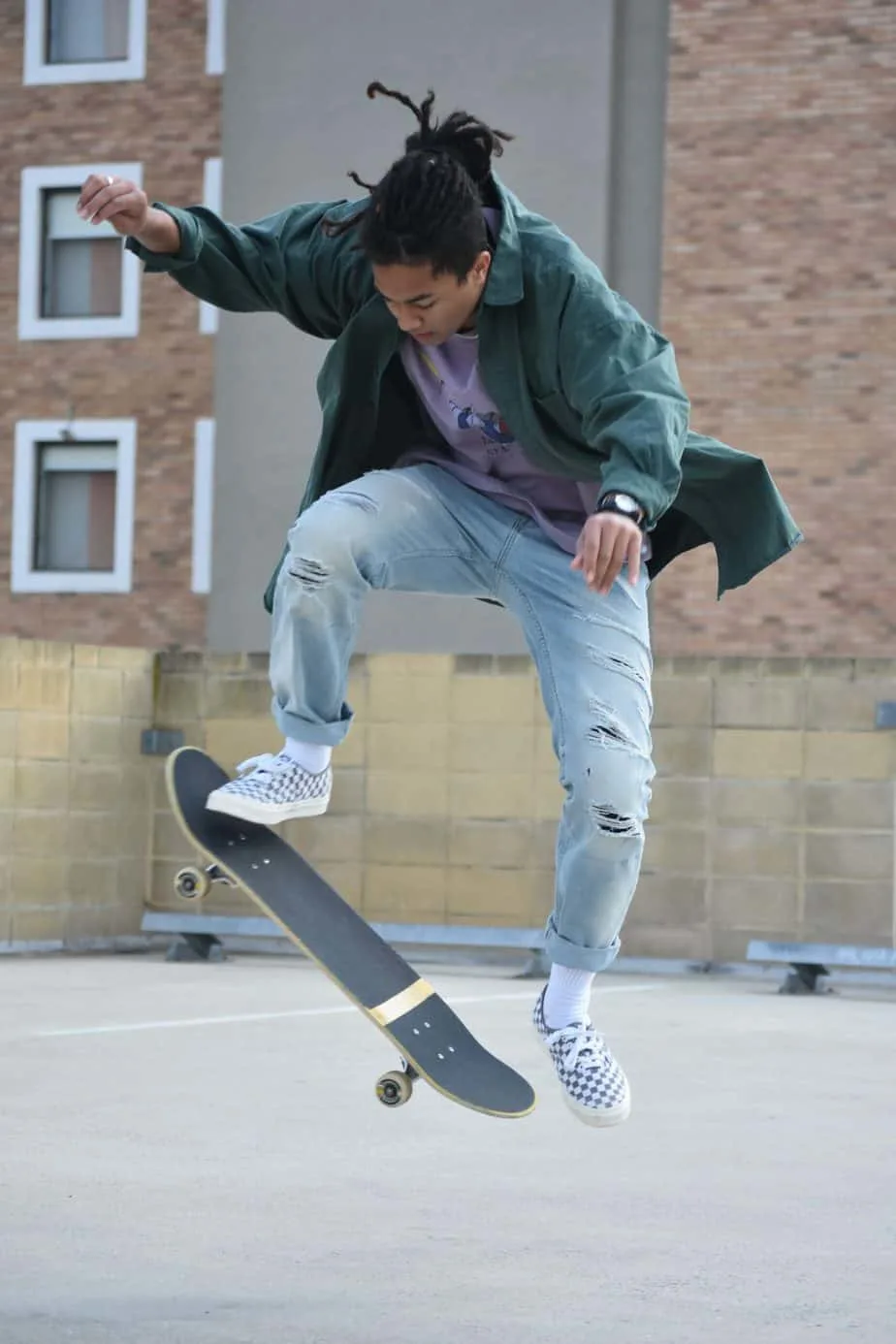
While it can be tempting you jump onto your new board and immediately attempt your first kickflip, it’s just not realistic. When you begin your skating journey, we would urge you to learn a handful of fundamental movements before you even so much as attempt a trick. This might seem we are trying to limit your fun but its actually the opposite. If you get your fundamentals down, you’ll be able to master tricks faster and more consistently. So we are doing you a favour, we promise. So here is a list of fundamentals to master before you attempt skate tricks:
- Rolling and stopping
- Turning
- Tic-tacs
- Pivots
- Reverts
- Kickturns
- Powerslides
- Sex changes
What are the Easiest Skateboard Tricks?
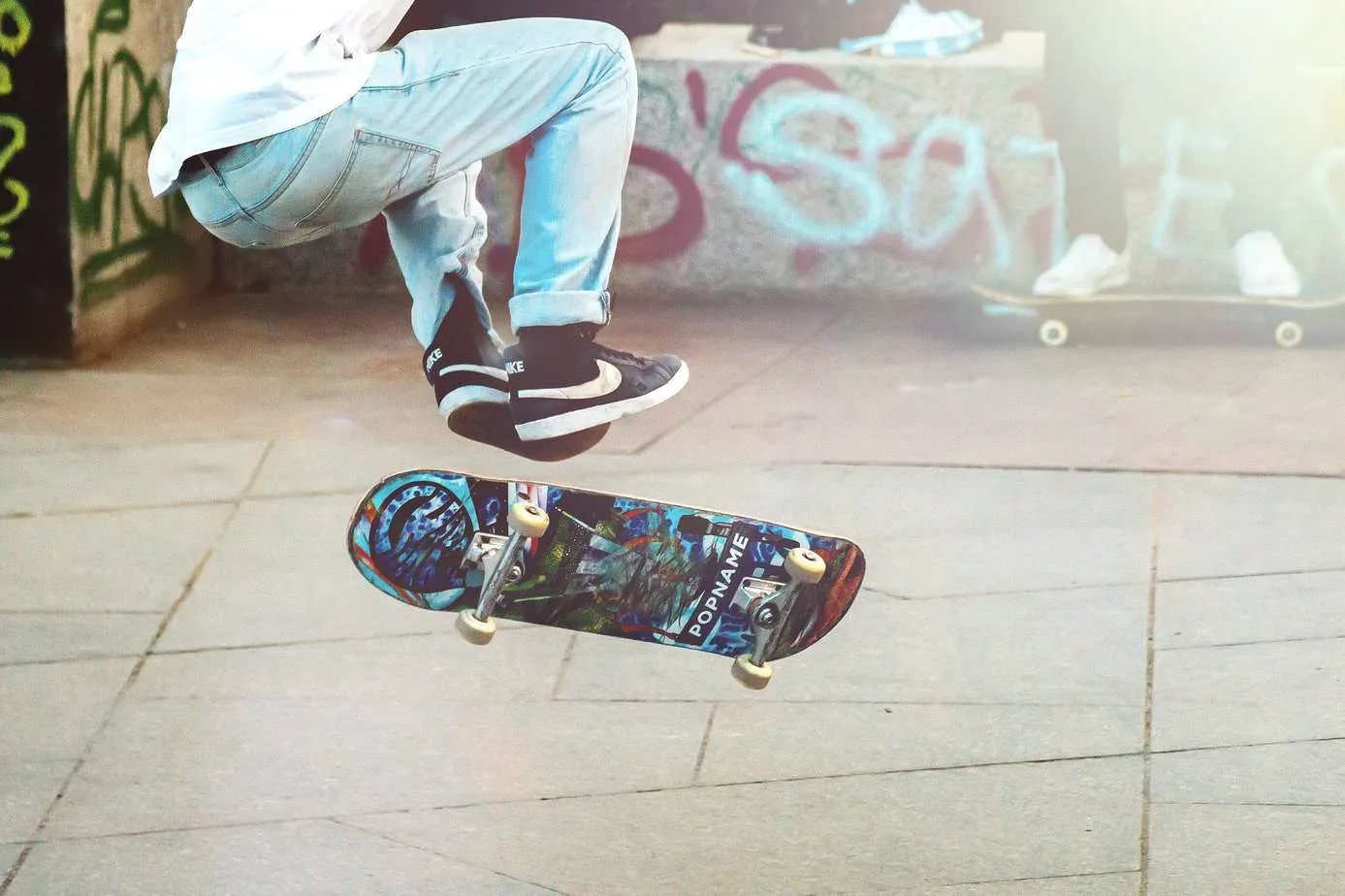
So now that we have an idea of what makes a trick difficult and what fundamentals we need to try out tricks, we can look at some easy tricks to try. To clarify, our selection process for these tricks were as follows:
- Tricks should include as few complexity factors as possible
- Tricks should be attainable in one session
- Tricks should exclude ramps, rails and ledges
- Tricks should be easy enough that a complete beginner could land them
- Should be complex enough that it still feels/looks like a good trick
So with this criteria in mind, here is our list of some easy skateboarding tricks that you can try before you master your ollies:
Strawberry Milkshake
If there was one trick that I would try to teach a non-skater by default, it would be this one. This is a static trick that looks impressive but in reality, it’s super simple. This trick involves the skater placing their heel on the tail of the skateboard when it is in the primo position. Then they push their heel back, wrap the board around their foot and then plant their dominant foot on the board when it comes around. Skaters can also make this one look even more impressive by landing on the board when it wraps around or, if you are a good freestyle skater, you can even do this while moving to make it look super slick.
Curb Stall
I know we said no ledges but we make an exception for curbs. They are a nice mellow entry to skating objects and a curb stall is a great trick to kick things off. You can perform this as a tail stall or a nose stall, depending on how comfortable you are in the respective stances. Simply roll up to a curb with a slightly wider stance on the board than usual, then lift your nose/tail and plant it on the curb, apply pressure to lift your wheels off the ground. Then to finish it off, dip the side of the board hanging off the curb and pop up to do a makeshift ollie, freeing you from the curb and allowing you to roll away in style.
Curb Drop/Firecracker
Speaking of curbs, while ollies may be out of your reach, that doesn’t mean that you can’t ride down these obstacles. If you approach any small drop of this nature at a decent speed and tip your nose up slightly as you reach the drop like a manual, you will descend the curb and ride away smoothly. You can even do this down stairs with a move called a Firecracker. This is where you approach a set of stairs and maintain this manual stance all the way down, allowing your tail to smack off each stair as you go and keep you steady. This tends to only work for smaller sets like 3/4 steps but can be really fun and satisfying to perform.
Caveman
This one is a really simple move that looks really cool, especially if you commit to it and jump from heights. This is when you are standing on the ground with the board in your hand. Then you bring the board up to about knee height, let it go while simultaneously bringing your feet up to meet the board by jumping. Then you set yourself, bend your knees to absorb the impact and ride away. This is a really cool way to start a line and is infinitely more stylish than a static start.
Boneless
This one is quite similar to the caveman in a lot of ways, however, to perform this trick you will have at least one foot on the board at all times. To do this trick, you will begin rolling or standing on the board. Then you will need to place your foot closest to the nose on the ground, reach down and grab the side of the board with your hand. Then you will stand up, spring off the foot on the ground, take flight and then bring both your feet onto the board for a smooth landing. This can be a cool way to get up onto ledges in an alternative way.
Shuv-its
While many believe that shuv-its are a trick that comes after ollies, that isn’t always the case. Unlike the pop-shuv-it, you don’t need to pop this trick. All you have to do is use your dominant foot to scoop the board around, while you jump up and slightly forward, following the direction of the board and then landing when the board has made a complete half rotation. This can be a tricky one to master but so long as you really emphasise the scooping movement, you will get it.
Hippie Jumps
This is yet another fun little trick that technically involves an obstacle but we make an allowance here as it’s a very easy trick. A hippy jump is when you roll up to an obstacle that you can jump over and the board can roll under. For example, a handrail would make for a great obstacle to hippy jump. To perform the trick, you simply roll up to the obstacle, then jump directly upwards when you reach the rail. Jumping forward will only send the board backwards. However, if you jump up the forward momentum from rolling up to the obstacle will carry you over and then you simply land on the board and ride away. It looks simple but it might take you a few attempts to build up the confidence to land this one.
Biebelheimer
Our penultimate easy trick is the biebelheimer. This is a trick that sees the skater drop their board, allowing it to flip using the ground as a means of doing so, then the skater jumps on and rides off. Tgus is a good alternative to the caveman and many people call this trick ‘the lazy caveman’. A bonus tip, to ensure that the board flips over consistently, begin with the nose of the board facing away from you and try to drop the board directly on the nose, as this will force the board to flip over most of the time.
No Comply
Then lastly, we have the no comply. This is a trick that smoothly allows the skater to rotate 180 degrees but involves no ollie whatsoever. To do this, the skater will begin in their natural position, then they will step off the board with their back foot and use their front foot to scoop the board around like a pop shuv. Then as the board rotates, the skater jumps up slightly and meets the board for the catch. This one is probably the trickiest of all those listed here but we still believe that with one long session dedicated to landing this, you will nail this trick.
What is the Easiest Fliptrick?
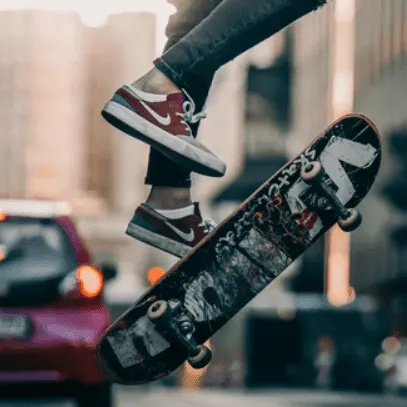
As you might have noticed, there were no flip tricks listed above and for good reason as even the most rudimentary of flip tricks are a challenge. However, you may have mastered all the tricks in the list above and be wondering what the easiest flip trick would be to tackle. Well, we believe that it is a tie between the kickflip and the heelflip. In terms of technique, the tricks are incredibly similar as you are basically flicking the board around one way or the other. It really comes down to which one you try first in most cases. Every other flip trick will use these tricks as a base and only get more complex, adding rotations, spins and other factors. So we would say that if you feel up to the challenge, pick which of these tricks appeal to you most and give it a try.
What is the Easiest Transition/Vert Trick?
We didn’t include any ramp tricks on our list as let’s face it, ramps are intimidating, especially for beginners. However, there actually are several tricks that you could try out on a mini-ramp that you could easily master in one session. The easiest of them all, depending on if you would consider it a trick, is dropping in. This is when the skater hangs their wheels over the coping, leans into the drop and rolls down a ramp at speed. For us, we believe that this trick is 10% technique and 90% confidence. So provided you really want to go home with this trick in your repertoire, we believe you will.
However, a handful of skaters wouldn’t call this a trick and rather an essential skill for learning tricks. So if you are in that camp, we would suggest that the easiest trick on a ramp is the rock to fakie stall. This is when the skater rides up the ramp, pushes their front trucks over the coping, stalls on the board and then pops their front trucks back over the coping, riding away fakie on the way down. It sounds technical and scary, but we assure you, this one is very attainable so long as you remain confident in your abilities.
Common Misconceptions Made By Beginners
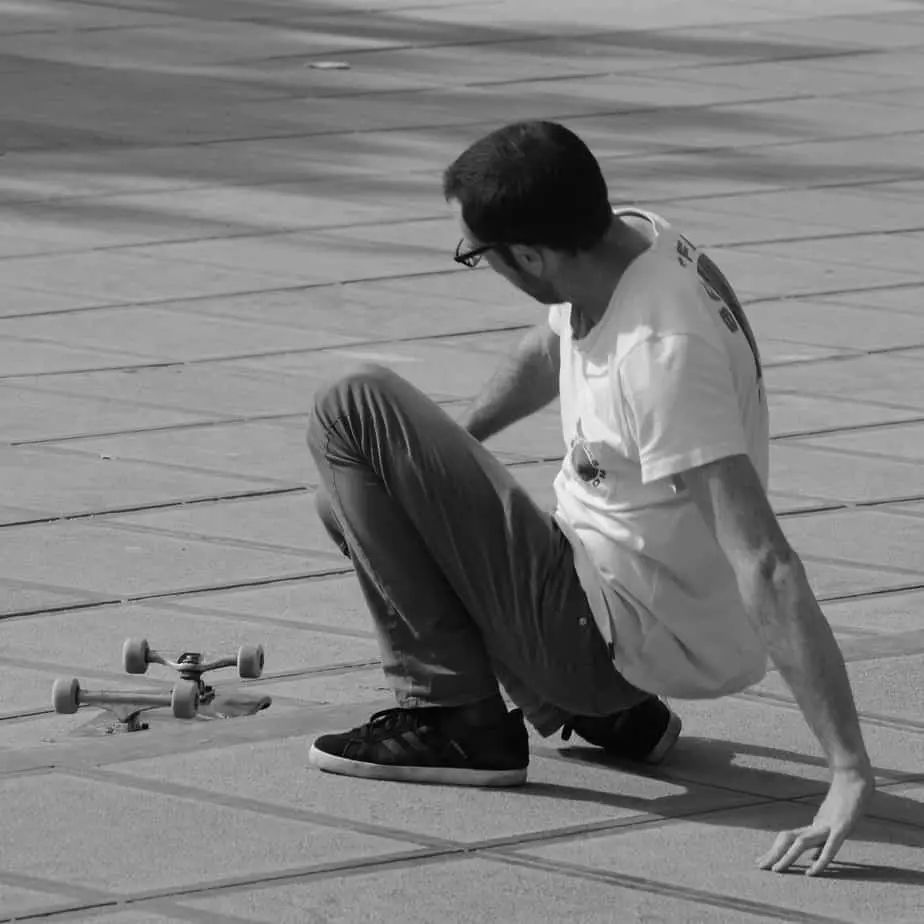
It’s probably a good idea to talk about some of the common misconceptions that beginners carry with them when beginning their skating career. These misconceptions can often be harmful when it comes to one’s enjoyment of the sport and for that reason, we feel it our duty to temper expectations and give you the 411 on skating. Here are some misconceptions you need to understand and avoid:
Skateboarding is Easy
It sounds so silly to say but there are plenty of watchers on that believe that they could do a better job than veteran skaters with no practice whatsoever. So when beginners jump into the sport, some of them carry this attitude into the world of skating. However, the board soon teaches this overconfident skater that skating is a very technical and tough nut to crack. So if you are about to take up this fun activity as your sport of choice, know that tricks probably won’t come for a while, you won’t land a kickflip on your first day and you will look a little silly and probably fall. However, that’s ok and the supportive skating community will help you as best as they can.
Everyone is Laughing at me
This one is a common one but we can assure you, it’s complete nonsense. For the most part, bystanders don’t really care what you are doing unless you are in their way, so don’t feel like all eyes are on you. The only time that this will be the case is with fellow skaters. You may feel that your peers are sniggering and laughing at your attempts to learn the basics but we assure you, it’s paranoia and nothing more. Skaters by and large are supportive and helpful and the community as a whole is a wholesome one. So learn at your own pace and don’t let your insecurities get the better of you.
What Can I Do to Make Learning These Tricks Easier?
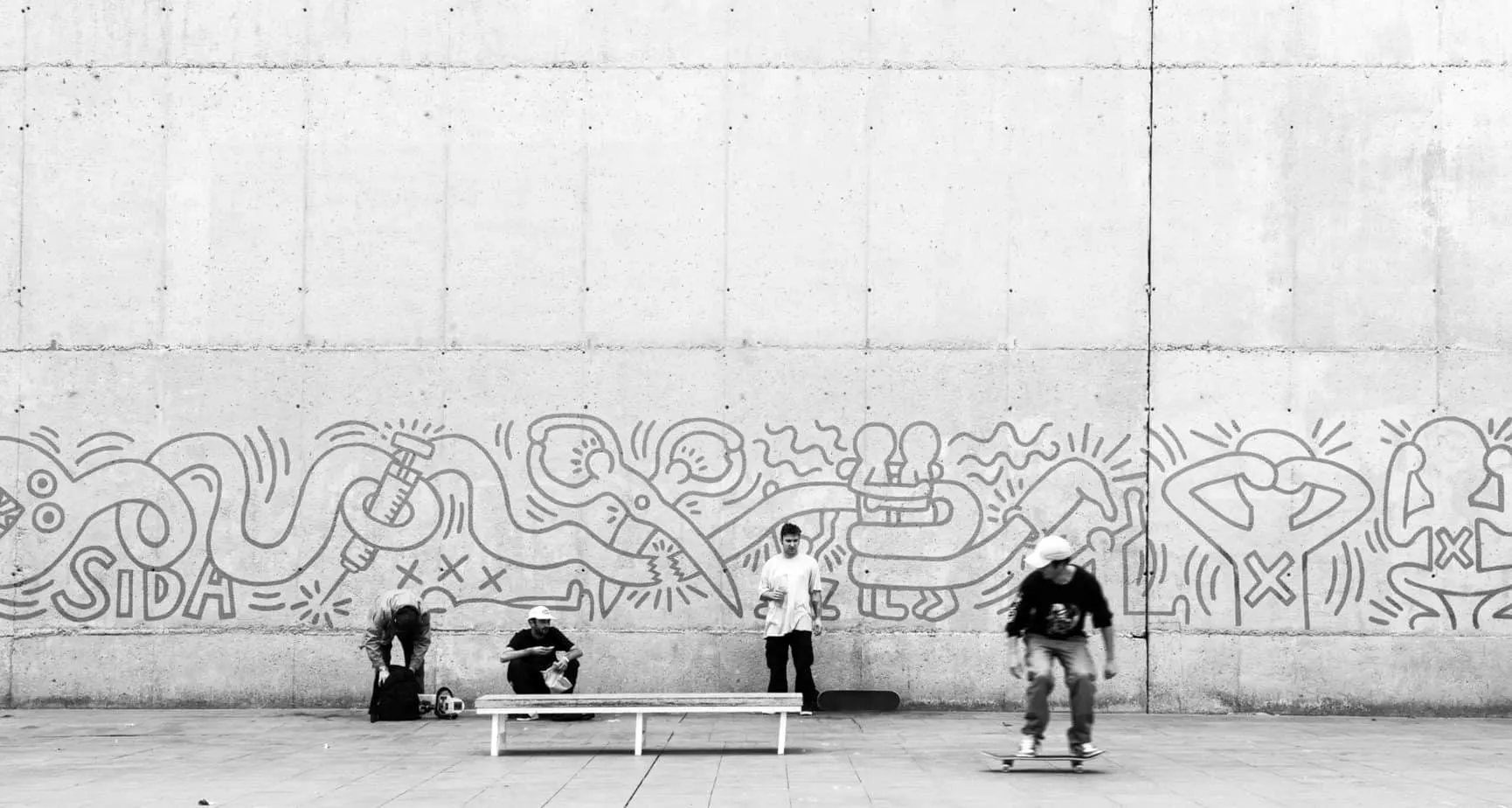
If you have got this far in the article, then you may have sensed the overall message I’ve been trying to convey. Skate tricks are hard and that’s something that we have to accept and work hard to overcome. However, there are some things that we can do to make this learning process a little smoother and less stressful. Here is a quick list of things that you can try:
Take Breaks
In the initial stages, you’ll be doing a lot of trick attempts, meaning lots of jumps, flicks, turns and general exertion. However, chances are that you won’t land a lot of these attempts. So, if you keep exerting yourself, you can expect diminishing returns as you continue with your session. To combat this, we would urge skaters to take regular breaks to just chill, ride around, talk to fellow skaters or if you are super dedicated, go watch some slo-mo clips of the trick you are trying while you relax. Maybe this will be the key that unlocks this trick. Whatever you do, just be sure to take the load off now and again to avoid burnout.
Watch/Read Tutorials
Back in the day, skaters didn’t have the resources that we have today, like Youtube for example. This allows skaters to watch videos of the tricks they want to emulate, mark out the smaller details of the technique required and then put that into practice in a matter of moments. Decades ago, skaters would have had to buy skate parts on VHS and commit that video to memory. So use this to your advantage and nail your tricks much faster.
Ask Other Skaters
Few people can help you learn a trick faster than skaters who have mastered them. If you notice someone in the park that is ripping it up and doing tricks that you would love to learn, roll up and ask them for tips. Chances are that they will be more than happy to give you some pointers.
Buy Learning Gear
There are several products out there that are made with beginner skaters in mind. These products usually take the perils of skating out of the equation and make it so that you can focus on the task at hand. The best example is probably the silicone skate trainer wheels which stop your board from rolling, allowing you to practice static tricks without any chance of the board slipping out from under you. If this sounds like something that will help you learn faster, be sure to invest.
Great Beginner Learning Gear
As we briefly mentioned above, there are several skateboarding products out there that are focused on helping skaters learn how to perform tricks with more confidence and with more consistency, which is all we really want as skaters. The feeling of landing a trick for the first time is the epitome of joy, so why not invest in some products that help you attain that feeling time and time again. Here are our favourite items that you may want to grab for yourself:
Skate Trainer Sillicone Wheel Covers
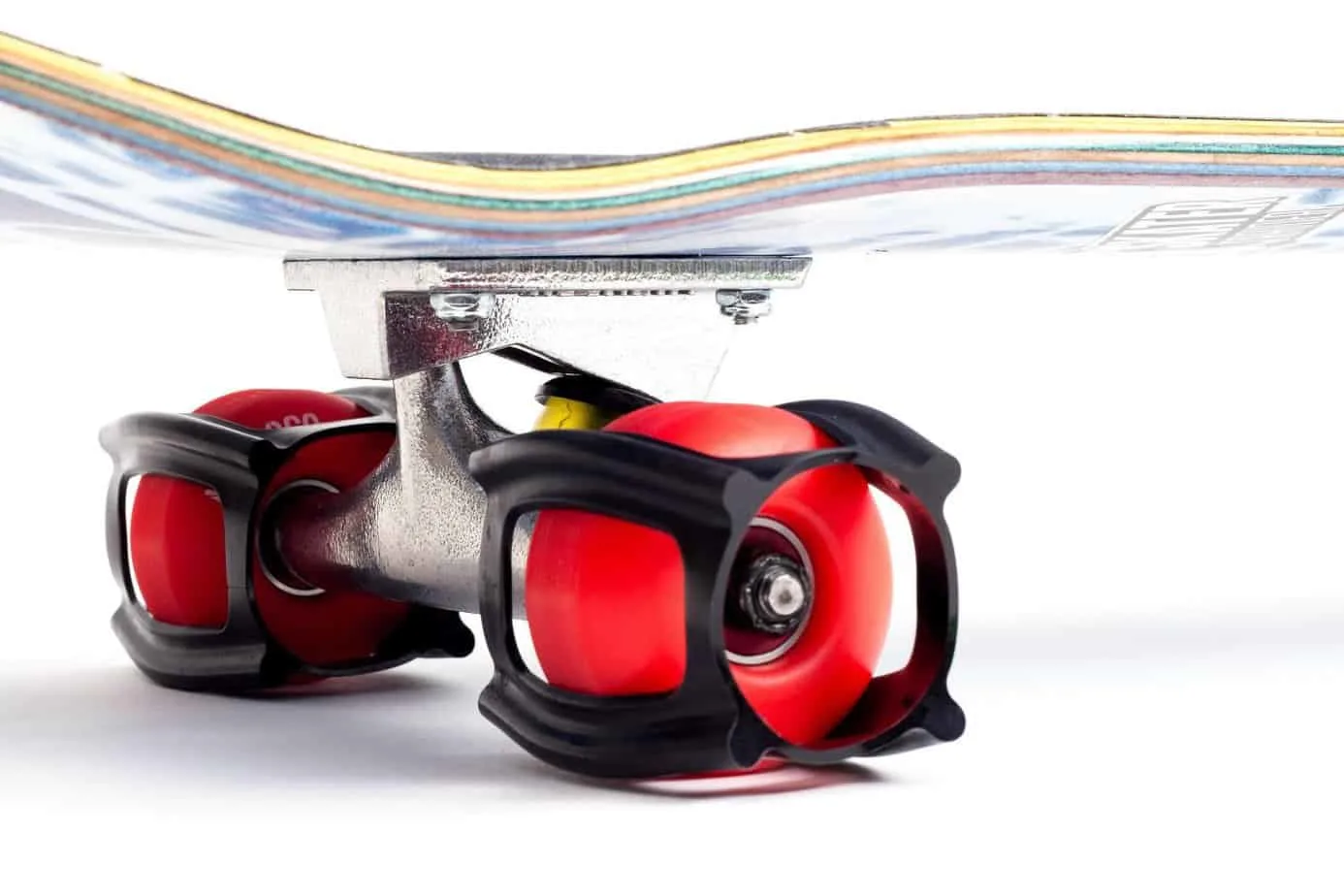
Firstly, we have the aforementioned Skate Trainer Wheels. These bad boys allow you to practice any flat ground trick that you want without the danger of the board slipping out from under you. Making the wind up and the landing a much more simple process, meaning you can focus on the technical aspects of the trick. These are relatively inexpensive, come in a variety of colours and make a great gift for anyone who has recently taken up skating.
Pros
- Comes in a variety of colours
- Easy to put on/take off
- Portable
- Well priced
Cons
- Learning tricks static can teach bad habits so best not to rely on these
Bones Vato Rat Skate Wax
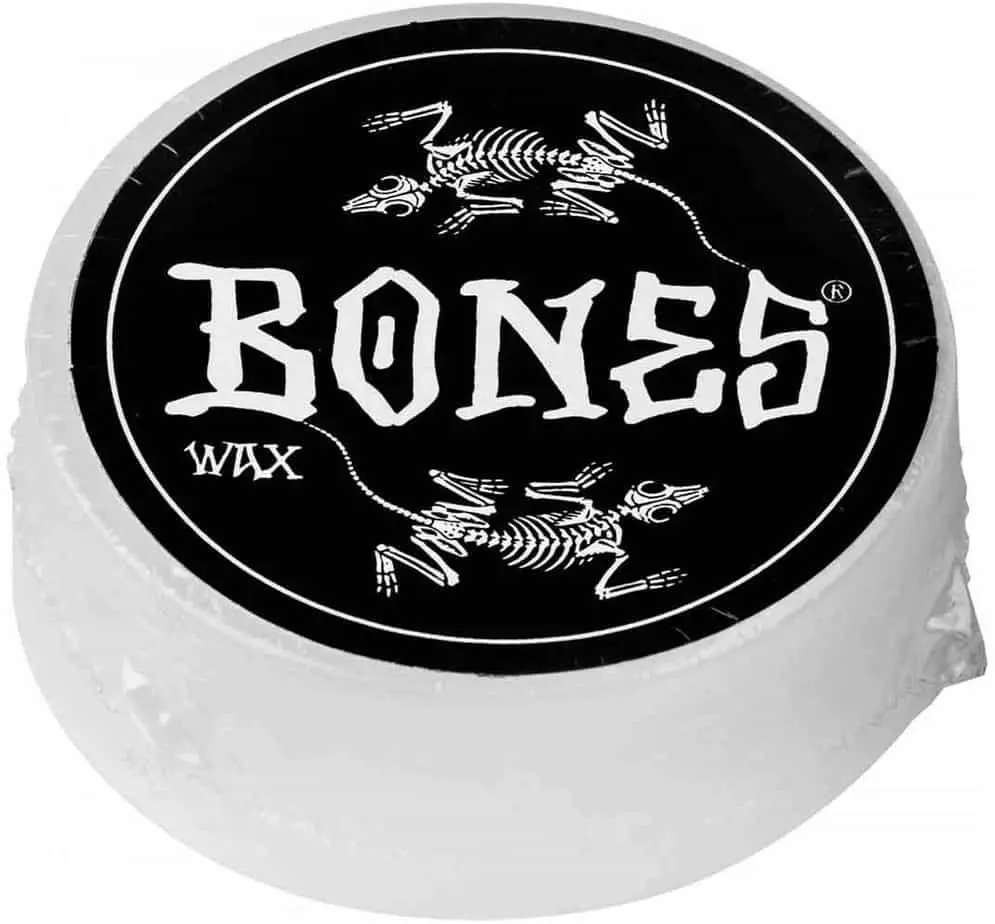
If you are in a position where you think it’s time to learn to grind, wax is a must have. Not only is this great to use on rails. You can use this on curbs and even the ground if you want to do some mad power slides. The majority of skaters will do their first 50-50 on a curb and without wax, this simply isn’t possible. Wax is such a common skate accessory but we went with Bones as it’s a reputable brand and it’s design is no thrills.
Pros
- Reputable brand
- Removes friction beautifully
- Decent amount in the pack
- Inexpensive
Cons
- Some skaters prefer the colourful and loud designs of other brands
Skate Hut Pro Pad Set
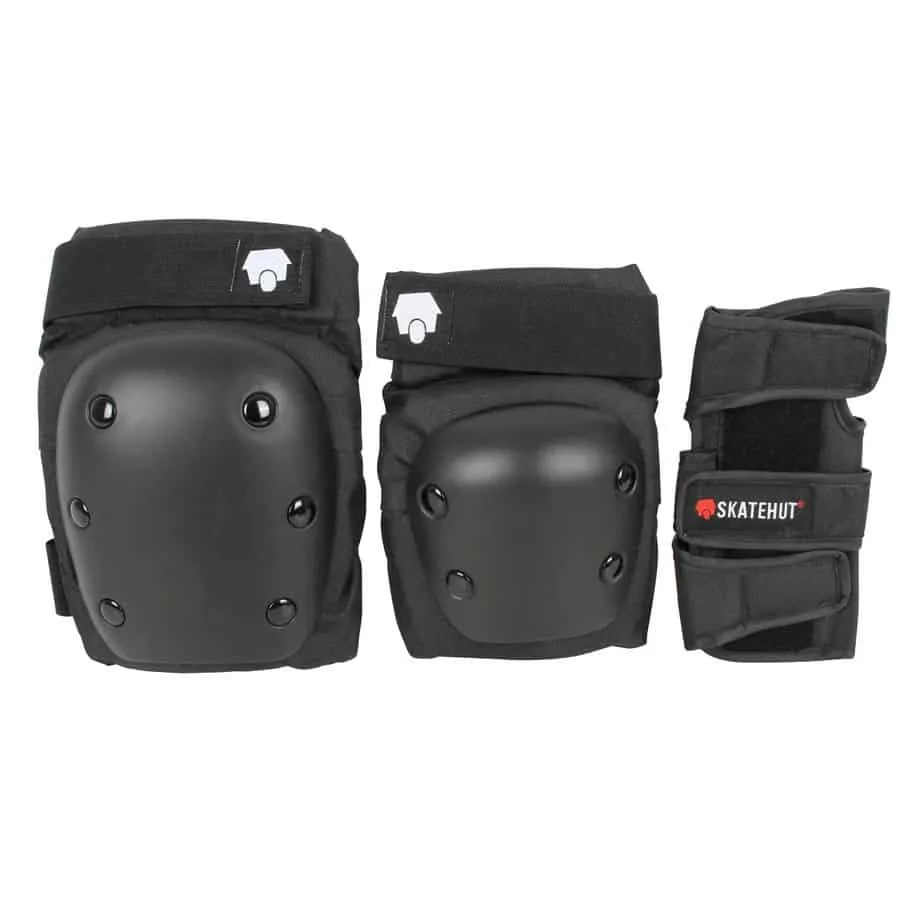
Then lastly, if you want to make sure that you don’t suffer an injury that sidelines you and sets you back on your way to learning new tricks, then you need some protective pads. This set comes with both elbow and knee pads. They are sturdy, well priced and have a simple design which is what we personally prefer from pads.
Pros
- Comes with elbow and knee pads
- Simple design
- Well priced
- Strong and durable
Cons
- Some skaters may also want to purchase wrist guards and need to do so separately
What Are the Hardest Skate Tricks?
Then lastly, to play devil’s advocate, why don’t we take a look at some of the most challenging tricks that you can attempt on a skateboard. Now, obviously, we could be here all day naming challenging tricks as modern skating is chocked full of new and awe-inspiring tricks. So we are just going to name the tricks that we personally feel are a step above the rest in terms of difficulty. Take a look down below:
- Dolphin Flip
- Laser Flip
- Impossible
- Merlin Flip
- Darkslide grind
- Kickflip underflip
- Tre double flip
- Alpha flip
- Hardflip
- 360 inward Heelflip
- Gazelle flips
- Beta Flip
About As Easy as it Gets!
As you can see from the information above, skating is not easy and no trick is inherently simple. However, several tricks are much less challenging than others and make a great starting point for beginner skaters. We hope that this guide has been helpful for you and gave you some ideas as to which tricks to try next time you hit the park. Remember, skating isn’t a race. Just do your best and before you know it, you’ll be landing the hardest of tricks first try!
FAQ Section
Answer: These are the three different disciplines of skating. Here is a quick description of each below:
• Street: This is essentially flat ground skating and can include obstacles such as handrails, hubbas, manny pads, stair sets and ledges.
• Transition: This is an amalgamation of street and vert. This will include the obstacles above such as rails, stairs, ledges etc. However, it will also include things that add vertically to the park such as quarter pipes, kickers, banks etc.
• Vert: This is 100% ramps. This usually takes place on a very steep half-pipe and the aim of the game is to pump, gain speed and perform tricks using only the ramp in question. It’s all about getting air, doing stalls and grinds.
Answer: Only if you want to do the vast majority of tricks within the world of skating. Not only are ollies a skill that allows you to navigate on your skateboard competently. This trick allows you to get the board into the air, giving you a platform to flick, spin, rotate, wrap and grab the board with enough time to set up for a smooth landing. We cannot understate how important an ollie is. So if you are out there trying flip tricks and you can’t ollie, you need to check your priorities.
Answer: It really depends on the context here. If you are a pro and you are trying a nollie tre flip into a noseblunt down a stair set. Then we would say that yes, your gear needs to be inch-perfect as small gains will matter. However, if you are just trying to get your first ollie, we would just urge you to make sure that all the components work. They don’t need to be the best of the best, they just need to do their job. So don’t sweat the small stuff.
So that is our guide detailing the easiest skate tricks that you should try. What do you make of this list? Have you landed any of these easy tricks? Are there any tricks that you are trying at the moment that are giving you trouble? Let us know in the comments section below and as always, thank you for reading Skate Culture Insider.
Ready to learn more tricks? Check out:

